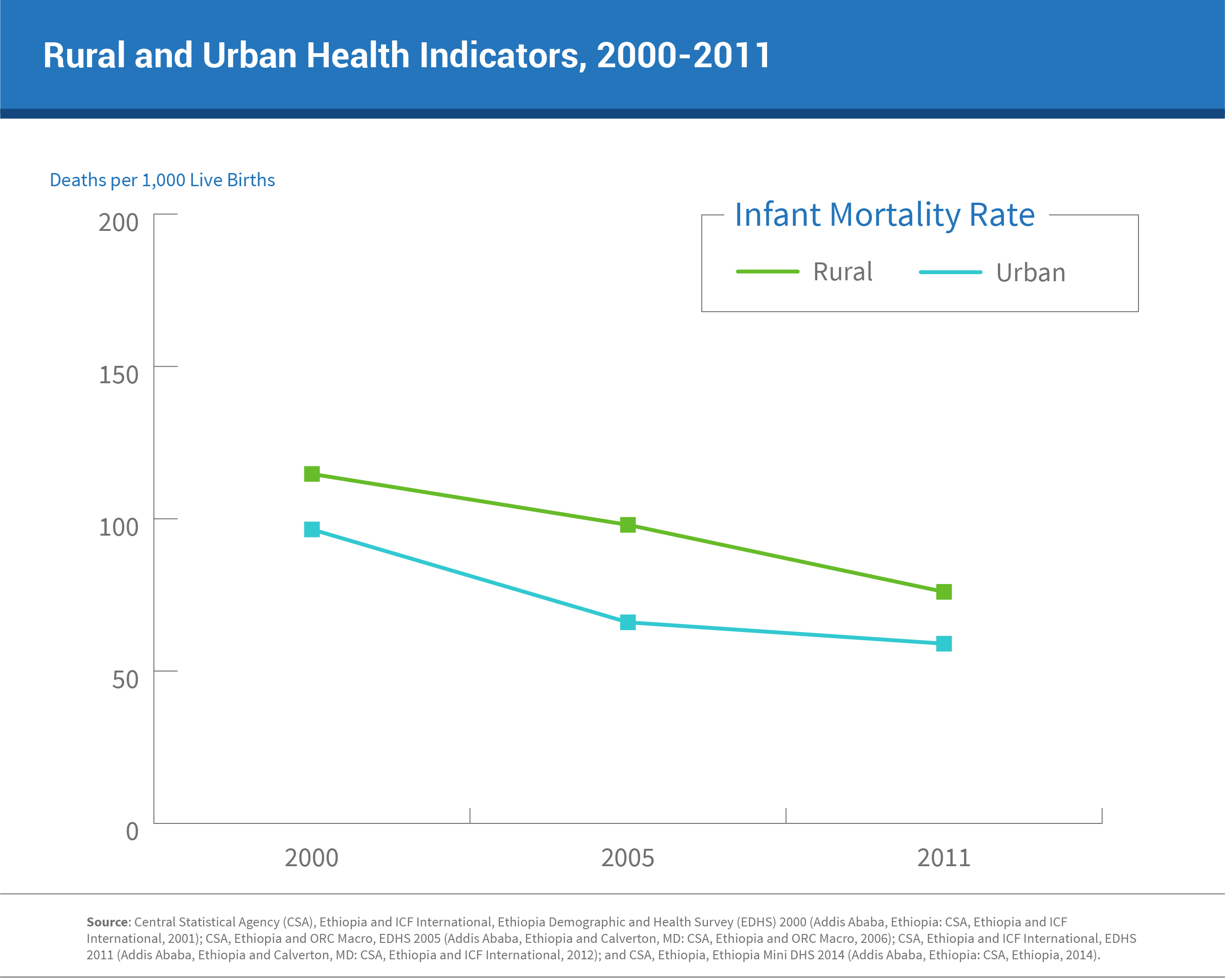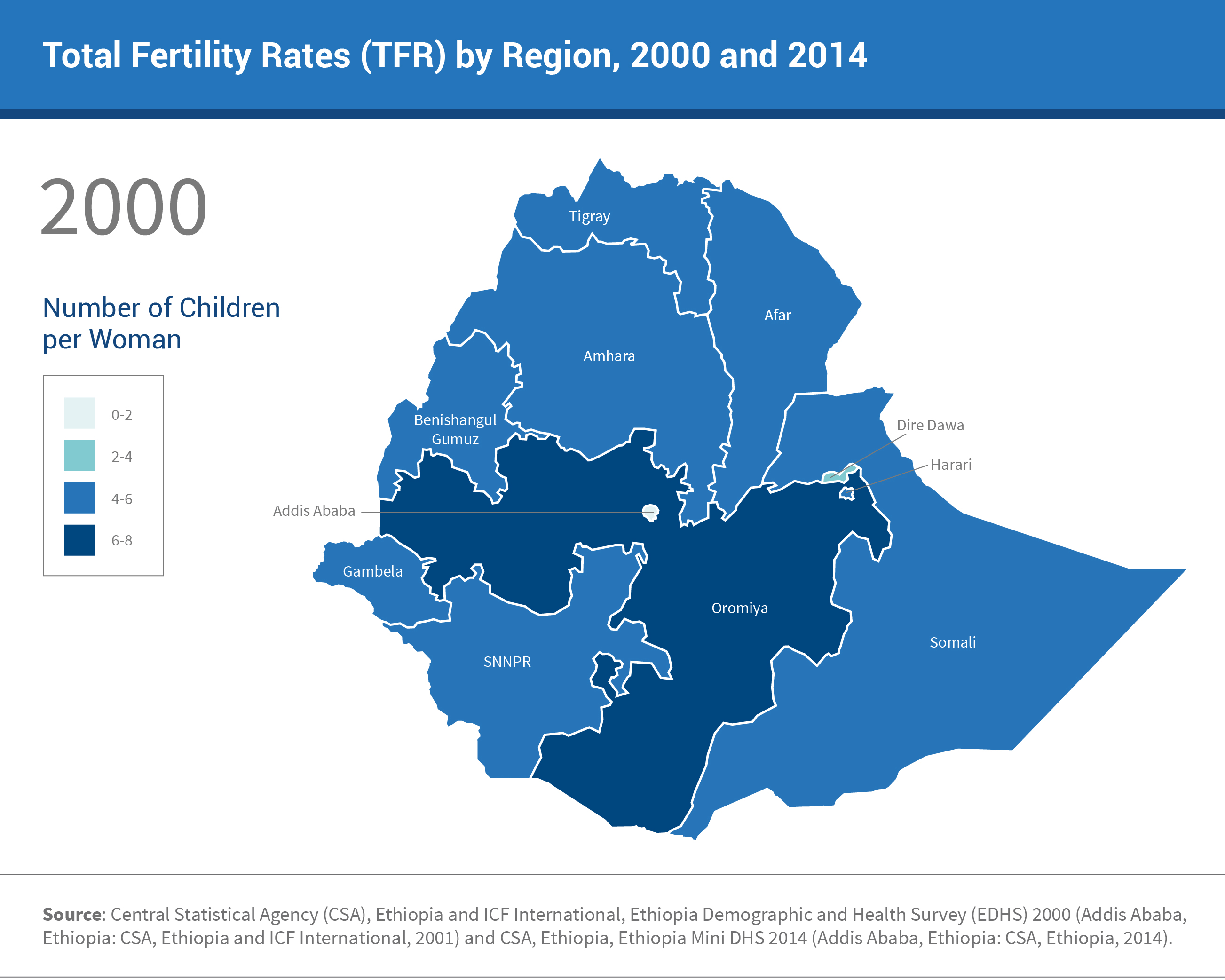Assefa Admassie
Principal Researcher at the Ethiopian Economics Association (EEA)

August 1, 2017
Principal Researcher at the Ethiopian Economics Association (EEA)
Senior Research Fellow at the Ethiopian Economics Association (EEA)
Former Program Director
Ethiopia, with a current population of about 100 million, has achieved gains in several major health indicators that place it in a favorable position to benefit from a demographic dividend in the future.
In recent years, Ethiopia has extended health infrastructure and services to improve the health of citizens, especially women and children, with significant improvements in indicators such as fertility, child mortality, and life expectancy.1 Reductions in fertility and mortality rates have yielded a rapidly growing youth population, with over 70 percent of the population under age 30 and nearly 50 percent under age 15.2
A demographic dividend is the accelerated economic growth that may result from a rapid decline in a country’s fertility and the subsequent change in the population age structure. With an increasing working-age population and decreasing dependent-age population due to sustained lower fertility, Ethiopia can reap a demographic dividend if policies and investments continue to be tailored to tap into this potential for economic growth and development and if areas of existing inequality are addressed.3
Despite achievements at the national level, similar trends are not consistently reflected at the subnational levels due to Ethiopia’s diversity in culture, ecology, and socioeconomic conditions.4 Ethiopia’s Demographic Health Survey (DHS) data show vast differences in fertility and other health and education indicators between rural and urban Ethiopia and across regional states (see Figure 1).5 Examining indicators for the regional states in terms of fertility, child mortality, and education is important for understanding where efforts may need to be intensified for Ethiopia to achieve a demographic dividend. Investments in health care and education both at the national and subnational levels will be critical in order to accelerate the demographic transition and to improve Ethiopia’s work force productivity.
Figure 1

Despite remarkable achievements in fertility reduction at the national level, this performance is not uniformly replicated at the subnational level and between urban and rural settings. Fertility is consistently higher among rural women, who give birth to nearly three more children during their reproductive years than urban women (5.5 versus 2.6 children per woman).6 Women in more remote and less developed regions give birth to more children than do women in the more developed regional states: The total fertility rate ranges from 1.7 children per woman in Addis Ababa to 6.4 children per woman in Somali, one of Ethiopia’s designated “emerging regions.”7 Fertility levels are higher than the national average in Somali, Benishangul-Gumuz, Afar, Tigray, Oromiya, and Southern Nations, Nationalities, and Peoples’ Region (SNNPR) and fertility is rising in Somali, Benishangul-Gumuz, and Afar (see Figure 2). The difference in fertility reduction between regions can be attributed to factors such as relatively delayed marriage for women in more advanced regions, levels of household wealth, and levels of education, with uneducated women having more children than women who have secondary or higher education.8
Figure 2

Increased contraceptive use is observed at both the national and subnational levels, also with regional variations. Although, urban women are more likely than their rural counterparts to use any method of contraception, use among currently married women in some rural areas has skyrocketed in recent years. For example, contraceptive use increased by more than six times in Amhara and SNNPR between 2000 and 2016. By contrast, in 2016 the contraceptive prevalence rate was only 2 percent in Somali, where contraceptive use has actually declined, indicating that reproductive-age women who might not want more children or might want to space births are not using family planning. These trends have significant implications for fertility reduction and prospective gains from any demographic dividend.
Overall, Ethiopia has made progress catching up with peer countries and has a lower infant mortality rate than the average across low-income countries in Africa.9 Before 2000, almost all regional states recorded more than 100 infant deaths per 1,000 live births, but by 2011 infant mortality in all regions was lower than 100 infant deaths, except for Benishangul Gumuz. By 2030, the infant mortality is forecast to fall to 31.5 per 1,000.10
Similarly, under-five mortality was 21 percent lower in 2011 than it was 10 years ago. Childhood mortality varies among regional states and is consistently higher in rural and emerging regions than in urbanized and advanced regions. The 2011 DHS data clearly illustrate that Benishangul Gumuz has the highest infant and under-five mortality rates at 101 infant deaths per 1,000 live births and 169 under-five deaths per 1,000 live births, followed by SNNPR, Gambella, and Amhara, while urban areas Addis Ababa and Dire Dawa have the lowest infant and under-five mortality rates. Nevertheless, even in Addis Ababa, one in 25 children dies before their fifth birthday.
Ethiopia, nationally and regionally, still continues to face huge gaps in access to education, which plays a critical role in female empowerment, fertility reduction, and sustainable development.11 Despite these gaps, Ethiopia has made significant strides: Primary school net enrollment rates reached 84 percent in 2016, a huge increase from less than 20 percent in the 1990s, and secondary education enrollment has similarly improved.12 Government expenditures on education increased from 2.3 percent of Gross Domestic Product in the early 1990s to nearly 4.5 percent in 2016.13
As with health indicators, education outcomes vary significantly among the regional states. Addis Ababa, Dire Dawa, and Harari have the highest literacy levels; Afar and Somali have the lowest literacy levels nationwide, followed by SNNPR and Amhara. A wide gender gap pervades the education system, especially at secondary and tertiary levels, with males considerably outnumbering females. The Ethiopian government has implemented policies to make schools more accessible and safe for female students, including construction of separate female bathroom facilities, hiring female teachers, and establishing counseling and guidance services.14 Gender parity in primary enrollment has substantially improved, but access to education continues to be skewed heavily toward males, with female enrollment and completion lagging at secondary and tertiary levels.
Achieving the demographic dividend requires sufficient investment in human capital development to produce a workforce capable of maximizing the country’s economic potential. The rapid reduction in fertility and child mortality has accelerated Ethiopia’s path toward the demographic dividend. However, harnessing this dividend at the national level will depend on the regional states’ ability to maintain and scale up investments in human capital. Because national averages often mask differences in health and education outcomes, a subnational perspective is important for equity considerations. Our analysis clearly shows that some Ethiopian regional states are not progressing sufficiently in terms of the main drivers of the demographic dividend and thus, require special and intensified attention. With increased attention to reduce health and education inequality between regional states and effective implementation of supporting policies, Ethiopia could earn a large demographic dividend and improve the quality of life for inhabitants nationwide.
1. Life expectancy in Ethiopia increased from about 36.7 years in the 1960s to 64.9 years in 2016, with female life expectancy (66.9 years) being almost four years higher than male life expectancy (63.0 years); U.S. Agency for International Development (USAID), Ethiopia Performance Monitoring and Evaluation Services (EPMES): Ethiopia Development Trends Assessment, draft, January 2017.
2. Ethiopia Central Statistical Agency (CSA), Ethiopia Mini Demographic and Health Survey (DHS) 2014 (Addis Ababa, Ethiopia: CSA, 2014); A large youth bulge can be a destabilizing factor if unemployment remains high but if managed properly, it can expedite the transition to a demographic dividend and to a period of accelerated economic productivity.
3. According to Mason and Kinugasa, demographics accounted for between 9 percent and 15 percent of the economic growth in East Asia between 1960 and 2000. Andrew Mason and Tomoko Kinugasa, “East Asian Economic Development: Two Demographic Dividends,” Journal of Asian Economy no. 19 (2008).
4. The Federal Democratic Republic of Ethiopia is composed of nine National Regional States and two Administrative States (Addis Ababa city administration and Dire Dawa city council). The national regional states as well as the two cities’ administrative councils are further divided intoworedas and urban and rural kebeles. Four of these regions—Somali, Benishangul Gumuz, Afar, and Gambella—are relatively less developed regions and are labeled as “emerging regions.”
5. Ethiopia CSA, Ethiopia Mini DHS 2014.
6. Ethiopia CSA and ICF International, Ethiopia Demographic and Health Survey 2011 (Addis Ababa, Ethiopia, and Calverton, MD: ICF International, 2012).
7. Somali, Afar, Gambella, and Benishangul Gumuz regional states are “emerging regions” in Ethiopia.
8. According to the Ethiopia’s DHS data, women in the lowest wealth quintile have a relatively higher total fertility rate (TFR) as compared with women in the highest wealth quintile.
9. USAID, Ethiopia Performance Monitoring and Evaluation Services (EPMES).
10. While these gains are impressive, Ethiopia still lags behind other countries in many health indicators and faces significant health and mortality challenges. Globally, Ethiopia ranks 150th out of 186 countries in infant mortality and 154th in life expectancy; USAID, Ethiopia Performance Monitoring and Evaluation Services (EPMES).
11. S.S. Shetty and V.B. Hans, “Role of Education on Women Empowerment and Development Issues and Impact” (2015), accessed at http://ssrn.com/abstract=2665898, on March 2017; J.A. Behrman, “Does Schooling Affect Women’s Desired Fertility: Evidence From Uganda, Malawi, and Ethiopia,” Demography 52, no. 3 (2015): 787-809; and E. Pradhan and D. Canning, “The Effect of Schooling on Teenage Fertility: Evidence From the 1994 Education Reform in Ethiopia,” Harvard PGDA Working Paper no. 128 (2015).
12. Ethiopia CSA and ICF International, Ethiopia DHS 2016: Key Indicators Report (Addis Ababa, Ethiopia, and Rockville, MD: ICF International, 2016).
13. USAID, Ethiopia Performance Monitoring and Evaluation Services (EPMES).
14. Rajendra D. Joshi and Adrian Vespoor, “Secondary Education in Ethiopia,” World Bank, Washington, D.C. (2013).
